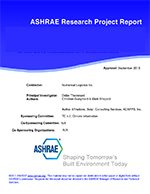Click here to purchase
A previous paper articulated the current problems faced by HVAC&R professionals involved in the conceptual design process and proposed a solution based on a knowledge-based expert system (KBES) approach, which can automatically synthesize all the feasible secondary and primary systems that can then be evaluated using currently available hourly building energy simulation programs. The previous paper described the general framework of such a KBES module called HVAC-KBCD. The module consists of (1) static knowledge (based on heuristics, design practice, and standards) containing assembly and application rules needed to prune or shrink the solution space of all feasible secondary and primary systems and (2) dynamic knowledge containing initiation and matching rules to provide a guided search and further shrink the solution space by imposing restrictions of how to combine secondary systems among themselves (since the building has several zones) and with primary systems. These capabilities, along with specially developed models for first and maintenance costs, have been programmed into a commercial KBES shell. This paper describes the type of knowledge specific to office buildings that needs to be coded into the HVAC-KBCD module and illustrates its capabilities when applied to a case study example. The case study serves to illustrate the relative ease and thoroughness with which this design assistant can generate and evaluate a large number of HVAC&R system design alternatives.
Citation: ASHRAE Transactions, vol. 110, pt. 1
Product Details
- Published:
- 2004
- Number of Pages:
- 16
- File Size:
- 1 file , 360 KB
- Product Code(s):
- D-21902


